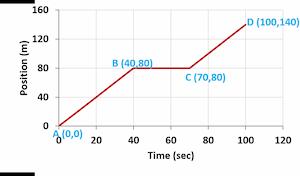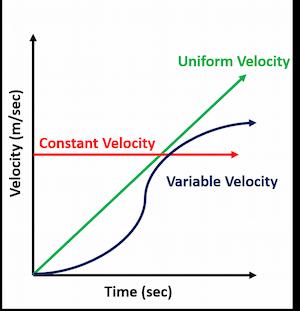The rate of change of position over a very short period of time is defined as instantaneous velocity.
The time interval is indefinitely tiny, therefore it’s similar to the average velocity.
The magnitude of the instantaneous velocity is known as instantaneous speed.
Keep reading to know “how to find instantaneous velocity?”

Table of Contents
Instantaneous Velocity Definition
Instantaneous velocity, which is a continuous function of time, determines a particle’s velocity at any point in time throughout its travel. We may calculate it at a given moment by taking the derivative of the position function, which gives us the functional form of instantaneous velocity v. (t). An object with uniform velocity may have the same instantaneous velocity as its standard velocity.
Key Points
- It’s calculated in the same way as average velocity, but with a shorter time period. We know that total displacement divided by total time equals average velocity for a given time span. The displacement approaches zero as the time interval approaches zero. However, the ratio of displacement to time has a non-zero limit, which is known as instantaneous velocity.
- If a body is moving with a uniform velocity, its vint will be equal to its standard velocity.
- It is the derivative of position with respect to time
- Vector quantity.
- SI unit is meter per second (m/sec).
- The product of mass and velocity is called momentum.
- The dimensions of velocity are [LT-1]
How To Find Instantaneous Velocity
Instantaneous velocity is the average velocity between two points on the path in the limit that the time and the displacement between the two points approach zero. It is obtained by dividing displacement (x) with a short time interval (t), such that the time interval tends to be zero.

Where Δt is the small-time interval, and x is displacement.
vint is a continuous function of time and gives the velocity at any point in time during the object’s motion. It can be calculated at a specific time by taking the derivative of the position function, which gives us the functional form of vint.
It can also be calculated by finding the slope of a position-versus-time graph at a specific time.

Other Types of Velocity
Unifrom Velocity
If the velocity of a body changes equally in equal intervals of time, then the body is moving with uniform velocity.
Relative Velocity
When two bodies are in motion then the velocity of one body relative to the other is called relative velocity.
Terminal Velocity
Steady speed achieved by a free-falling object through a gas or liquid is called Terminal velocity. During freefall, a paratrooper attains terminal velocity with which it comes to the ground.

Finding velocity on a position-time graph
Velocity (v) can be found by calculating the slope of position vs time graph.
By definition, Slope = changes in the y-axis ÷ Changes in the x-axis.
In the position-time graph,
Slope = changes in position ÷ Changes in time.
As shown in the figure on the right, we have three intervals AB, BC, and CD in the position-time graph.
Sope of line AB = (80-0) ÷ (40-0) = 2.
So “v” from A to B = 2m/sec.
The slope of line BC= (80-80) ÷ (70-40) =0.
Therefore, “v” from B to C = 0m/sec.
The slope of line CD = (140-80) ÷ (100-70) =2.
Similarly, “v” from C to D = 2m/sec.
Example Problem
- A particle moves along the x-axis according to x(t)=8t−2t2m. Find the at t =1 sec and t =5 seconds.
x(t)=8t−2t2m; v(t) =d(x)/dt; v(t) = 8-4t.
v(1) = 8 -4(1)m =8-4 = 4 m/sec
v(5) = 8 -4(5) =8 – 20 = -12 m/sec
2. The position of a particle is given by x(t)=3t+0.5t2m. Find the vint at t=0.5sec.
x(t)=3t+0.5t2m ; v(t) = (3 + 1t)m/sec.
v(0.5) = 3+1(0.5) = 3.5 m/sec

Velocity Time Graph
The horizontal axis of the velocity-time graph represents time, while the vertical axis represents an object’s velocity. A velocity-time graph can be used to calculate the distance traveled by an item. There are three different scenarios:
Case-1 (Constant Velocity)
When the body’s velocity increases at a consistent rate, the velocity-time graph has a horizontal straight line (shown in red color in the Figure). A constant velocity item moves at a constant speed in a constant direction. A constant velocity, in other terms, is motion in a straight line at a constant speed.
Case-2 (Uniform velocity)
When the body’s velocity increases at a consistent pace, we get a straight line that rises to the same height for the same amount of time (shown in green color in Figure).
Case-3 (Variable Velocity)
The velocity-time graph will be a curve when the velocity is growing at a variable pace (shown in dark purple color in Figure).
Difference between Instantaneous Speed and Instantaneous velocity
| Instantaneous Speed | Instantaneous Velocity |
| Scalar quantity | Vector quantity |
| Rate of change of distance for a time interval which is very small (almost zero) | Rate of change of displacement for a time interval which is very small (almost zero) |
| The speed of an object can never be negative | It can be negative |
| Does not involve direction | Involves direction |
Related Links
Centripetal Acceleration| 9- Easy Examples
Linear Acceleration
Can Displacement be Negative?
Dynamic Viscosity-An Overview
Kinetic Energy Formula
Velocity Formula & Definition
Momentum Equation| Definition and Examples
Frequently Asked Questions
1. Is Instantaneous velocity average velocity?
No, the instantaneous velocity is not equal to the average velocity.
The average velocity for a given time interval is equal to the total displacement divided by the total time.
Whereas, the vint of a body is the velocity of the body at any instant of time or at any point of its path.
2. What is Instantaneous speed?
The instantaneous speed at any given time is the magnitude of vint at that time.
It is a scalar quantity.
3. What are kinematic equations?
The kinematic equations describe the motion of an object with constant acceleration. These equations are a set of formulas that relate to the five kinematic variables which are displacement, time interval, initial velocity, final velocity, and constant acceleration.
4. What is the equation for momentum?
The momentum equation is simply the product of mass (m) and velocity (v) of a moving object
If an object is moving and has mass, then it has momentum.
The term “momentum of a body” refers to the quantity of motion a body possesses due to its mass and velocity. It is a measurable quantity because if an object is moving and has mass, then it has momentum.
5. How to find centripetal acceleration?
A moving body traveling in a circular direction experiences centripetal acceleration. It is pointing in the direction of the circle’s center. Some of the examples are given below:
- A car turning a corner/going around a roundabout.
- Rollercoaster doing a loop
- Clothes inside a washing machine.
- In the whirling of stone, due to tension in the string, an acceleration acts towards the center.
6. What is Kinetic energy?
- Kinetic energy is defined as the energy possessed by a body by virtue of its motion.
- The translational K.E of a body is equal to one-half the product of its mass, m, and the square of its velocity, v, or (1/2)mv2.
- The rotational K.E of a body is equal to one-half the product of its moment of Inertia, I, and the square of its angular velocity, ω, or (1/2)Iω2.
7. What is Work?
Work (W) is a force acting on an object in the direction of motion.
It is the product of Force (F) and displacement (S) in the direction of the force.
its unit is Joule.
W = F x S
8. What is Dynamic Viscosity?
The resistance to the flow of one layer of fluid across another layer of fluid is defined as dynamic viscosity. Viscosity is caused by friction inside a fluid. The intermolecular forces that exist between particles in a fluid cause it.
9. What is a polygon and Is a circle a polygon?
A polygon is not the same as a circle. From end to end, a polygon is a closed-form on a plane made up of a finite number of linked line segments. Because a circle is curved, it cannot be made from line segments and so does not meet the conditions for becoming a polygon. Check the full article “Is the circle a polygon?”.
Conclusion
This article explains how to find instantaneous velocity, formula, and method of calculation.
Some people consider vint the same as average velocity.
Both quantities are different. Average velocity accounts for motion occurring over a time period, and vint describes motion at an infinitely small interval of time.
We hope after reading this article you are able to understand the concept of vint.
If you have any questions, please feel free to comment or email at [email protected]
More Interesting Topics
Crest of a Wave| Wave Properties| Easy Key Points
Angular Displacement Formula| Easy Examples
Energy of Light
Author
Umair Javed
Umair has been working at Whatsinsight since 2020 as a content writer.
He has a Masters degree in Material Science.
- BCl3 Lewis Structure in four simple steps - November 1, 2023
- PH3 Lewis Structure in four simple steps - October 8, 2023
- PF3 Lewis structure in four simple steps - September 24, 2023



